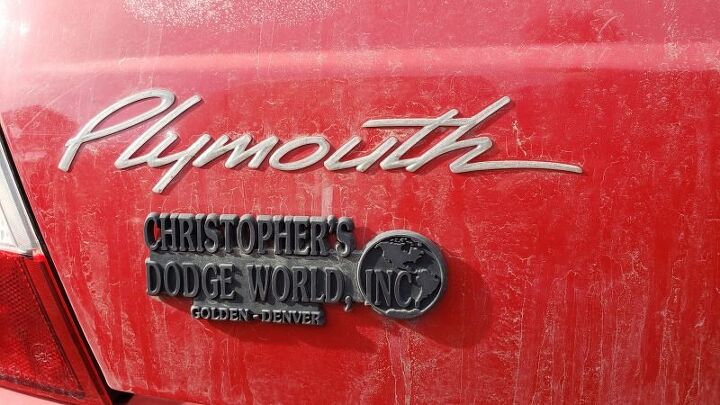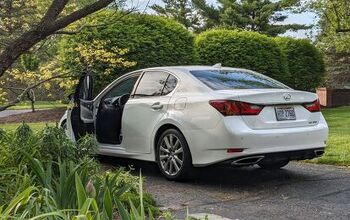369 Views
Junkyard Find: 2001 Plymouth Neon, Last Gasp of the Plymouth Brand Edition

by
Murilee Martin
(IC: employee)
Published: January 11th, 2021
Share
Quite a few hallowed (and not-so-hallowed) Detroit brands got axed forever during the decade of the 2000s (whatever we’re calling it now— the Noughts? the Oh-Ohs?), and the one that went to the slaughterhouse first was Plymouth. Starting in 1928 (not-so-coincidentally, just a couple of years after the birth of Pontiac), Americans and Canadians could buy low-priced Plymouths with the same running gear as the costlier Dodges and Chryslers, and life was good. Then the outlines of the brand became increasingly blurred as the 20th Century waned until finally just one Plymouth was left: the Neon. Last week, we saw one of the very last Pontiacs ever made, so we’ll follow that up with one of the final Plymouths.
The absolute last Plymouth to come off the assembly line was a Neon built at Belvidere Assembly in June of 2001. Today’s Junkyard Find was built in February of that year.
The Dodge Neon stayed in production all the way through the 2005 model year. Chrysler had become so eager to shed the Plymouth brand by the late 1990s that the Voyager minivan got plastered with Chrysler badging midway through the 2000 model year (after the November 1999 announcement of Plymouth’s impending termination), though the who-cares-anyway 2000 Breeze continued to stagger, zombie-style, into Plymouth showrooms for much of that year. The mighty Howler could have provided a little lift for Plymouth, but it appeared before the world with Chrysler emblems in 1999.
It may be red on the outside (except for the swapped-on silver hood), but the days of Bordello Red interiors in low-end Chryslers were long gone by 2001. This car appears to have upholstery provided by the same vendor responsible for the seats in prison buses.
With 132 horsepower from this 2.4-liter SOHC four, the second-generation Neon was a bit quicker than its low-trim-level Civic and Corolla competitors.
The three-speed automatic transmission in this car extracted most of the fun out of that engine before it could reach the wheels, though. The two-pedal 2002-2005 Dodge Neons got four-speed automatics, with only the Toyota Corolla CE and its Chevrolet Prizm twin remaining with three-speeds into the 2002 model year.
When you see rusty water stains all over the engine compartment of a car in the junkyard, you can assume the engine in question died from a blown head gasket followed by a few weeks of running straight water as coolant while the car’s final owner cycled through the various stages of Magical Overheating Thinking™ (my cousin’s neighbor says it’s gotta be the radiator cap… maybe it’s the thermostat…) and superheated steam hissed out of the weakest points in the cooling system. Eventually, the tortured engine finally seizes up and the junkyard gets a phone call.
Adios, Plymouth! We’ll remember you for the cool stuff, not the ’01 Neon.
{
"id": "9161717",
"alt": "",
"title": "",
"video_link": "https://www.youtube.com/embed/l8c5LRkxdW8",
"youtube_video_id": "l8c5LRkxdW8"
}
{
"width": 634,
"height": 357,
"showRelated": true
}
Chrysler didn’t bother to advertise the Plymouth Neon during its last couple of years, so here’s a somewhat disturbing TV commercial for the ’01 Dodge Neon R/T.
{
"id": "9161720",
"alt": "",
"title": "",
"video_link": "https://www.youtube.com/embed/eJJbktdanmc",
"youtube_video_id": "eJJbktdanmc"
}
{
"width": 634,
"height": 357,
"showRelated": true
}
Earlier in the Plymouth Neon’s life, buyers could choose between HI and YO. So edgy!For links to 2,000+ additional Junkyard Finds, Treasures, and Gems, visit the Junkyard Home of the Murilee Martin Lifestyle Brand™.
#2000s
#2001
#Chrysler
#ChryslerDeathWatch
#ChryslerNeon
#Colorado
#Denver
#Dodge
#DodgeNeon
#DownOnTheJunkyard
#Neon
#Plymouth
#Junkyard
#JunkyardFind
#PlymouthNeon
#MiserableEconoboxes

Murilee Martin
Murilee Martin is the pen name of Phil Greden, a writer who has lived in Minnesota, California, Georgia and (now) Colorado. He has toiled at copywriting, technical writing, junkmail writing, fiction writing and now automotive writing. He has owned many terrible vehicles and some good ones. He spends a great deal of time in self-service junkyards. These days, he writes for publications including Autoweek, Autoblog, Hagerty, The Truth About Cars and Capital One.
More by Murilee Martin
Published January 11th, 2021 9:00 AM
Latest Car Reviews
Read moreLatest Product Reviews
Read moreRecent Comments
- W Conrad I'm not afraid of them, but they aren't needed for everyone or everywhere. Long haul and highway driving sure, but in the city, nope.
- Jalop1991 In a manner similar to PHEV being the correct answer, I declare RPVs to be the correct answer here.We're doing it with certain aircraft; why not with cars on the ground, using hardware and tools like Telsa's "FSD" or GM's "SuperCruise" as the base?Take the local Uber driver out of the car, and put him in a professional centralized environment from where he drives me around. The system and the individual car can have awareness as well as gates, but he's responsible for the driving.Put the tech into my car, and let me buy it as needed. I need someone else to drive me home; hit the button and voila, I've hired a driver for the moment. I don't want to drive 11 hours to my vacation spot; hire the remote pilot for that. When I get there, I have my car and he's still at his normal location, piloting cars for other people.The system would allow for driver rest period, like what's required for truckers, so I might end up with multiple people driving me to the coast. I don't care. And they don't have to be physically with me, therefore they can be way cheaper.Charge taxi-type per-mile rates. For long drives, offer per-trip rates. Offer subscriptions, including miles/hours. Whatever.(And for grins, dress the remote pilots all as Johnnie.)Start this out with big rigs. Take the trucker away from the long haul driving, and let him be there for emergencies and the short haul parts of the trip.And in a manner similar to PHEVs being discredited, I fully expect to be razzed for this brilliant idea (not unlike how Alan Kay wasn't recognized until many many years later for his Dynabook vision).
- B-BodyBuick84 Not afraid of AV's as I highly doubt they will ever be %100 viable for our roads. Stop-and-go downtown city or rush hour highway traffic? I can see that, but otherwise there's simply too many variables. Bad weather conditions, faded road lines or markings, reflective surfaces with glare, etc. There's also the issue of cultural norms. About a decade ago there was actually an online test called 'The Morality Machine' one could do online where you were in control of an AV and choose what action to take when a crash was inevitable. I think something like 2.5 million people across the world participated? For example, do you hit and most likely kill the elderly couple strolling across the crosswalk or crash the vehicle into a cement barrier and almost certainly cause the death of the vehicle occupants? What if it's a parent and child? In N. America 98% of people choose to hit the elderly couple and save themselves while in Asia, the exact opposite happened where 98% choose to hit the parent and child. Why? Cultural differences. Asia puts a lot of emphasis on respecting their elderly while N. America has a culture of 'save/ protect the children'. Are these AV's going to respect that culture? Is a VW Jetta or Buick Envision AV going to have different programming depending on whether it's sold in Canada or Taiwan? how's that going to effect legislation and legal battles when a crash inevitibly does happen? These are the true barriers to mass AV adoption, and in the 10 years since that test came out, there has been zero answers or progress on this matter. So no, I'm not afraid of AV's simply because with the exception of a few specific situations, most avenues are going to prove to be a dead-end for automakers.
- Mike Bradley Autonomous cars were developed in Silicon Valley. For new products there, the standard business plan is to put a barely-functioning product on the market right away and wait for the early-adopter customers to find the flaws. That's exactly what's happened. Detroit's plan is pretty much the opposite, but Detroit isn't developing this product. That's why dealers, for instance, haven't been trained in the cars.
- Dartman https://apnews.com/article/artificial-intelligence-fighter-jets-air-force-6a1100c96a73ca9b7f41cbd6a2753fdaAutonomous/Ai is here now. The question is implementation and acceptance.




















































Comments
Join the conversation
I see Neons every day. Three of them in fact, and searching hard for a 4th!!
I recall the first generation of Neons were built without Dodge and Plymouth brand badges and shipped to the dealers where the brand badges were applied. Bingo - no need to segregate two bunches of otherwise identical cars at the factory before shipping.